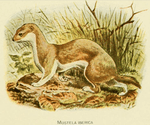Least weasel
| Least weasel Temporal range: Late Pleistocene–Recent | |
|---|---|
 | |
| Least weasel at the British Wildlife Centre, Surrey, England | |
| Scientific classification | |
| Kingdom: | Animalia |
| Phylum: | Chordata |
| Class: | Mammalia |
| Order: | Carnivora |
| Family: | Mustelidae |
| Genus: | Mustela |
| Species: | M. nivalis |
| Binomial name | |
| Mustela nivalis Linnaeus, 1766 | |
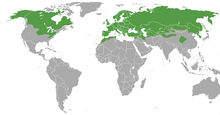 | |
| Global range of M. nivalis | |
The least weasel (Mustela nivalis), or simply weasel in the UK,[2] is the smallest member of the genus Mustela and of the family Mustelidae (as well as the smallest of the Carnivora), native to Eurasia, North America and North Africa, though it has been introduced to New Zealand, Australia, Malta, Crete, Bermuda, Madeira Island, the Azores, the Canary Islands, Sao Tome, the Falkland Islands, Argentina and Chile.[3] It is classed as being of least concern by the IUCN, due to its wide distribution and presumed large population.
Least weasels from various parts of its range vary greatly in size. The body is slender and elongated and the legs and tail are relatively short. The colour varies geographically, as does the pelage type and length of tail. The dorsal surface, flanks, limbs and tail of the animal are usually some shade of brown while the underparts are white. The line delineating the boundary between the two colours is usually straight. At high altitudes and in the northern part of its range, the coat becomes pure white in winter. Eighteen subspecies are recognised.
Small rodents form the largest part of the least weasel's diet, but it also kills and eats rabbits, other mammals, and occasionally birds, birds' eggs, fish and frogs. Males mark their territories with olfactory signals and have exclusive home ranges which may intersect with or include several female ranges. Least weasels use pre-existing holes to sleep, store food and raise their young. Breeding takes place in the spring and summer, and there is a single litter of about six kits which are reared exclusively by the female. Due to its small size and fierce nature, the least weasel plays an important part in the mythology and legend of various cultures.
Taxonomy and evolution
The least weasel was given its scientific name Mustela nivalis by Carl Linnaeus in his 12th edition of Systema Naturae in 1766. The type locality was Westrobothnia in Sweden. As an animal with a very wide distribution, the morphology of the least weasel varies geographically. The species was reviewed by Reichstein in 1957 and again by van Zyll de Jong in 1992 and Reig in 1997. Youngman (1982) placed it in the subgenus Mustela while Abramov (1999) considered it should be included in the subgenus Gale. Based on skull characteristics, Reig (1997) proposed that the taxon should be split into four species, M. subpalmata, M. rixosa, M. vulgaris and M. eskimo. Abrimov and Baryshinikov (2000) disagreed, recognising only M. subpalmata as a separate species.[4]
Within the genus Mustela, the least weasel is a relatively unspecialised form, as evidenced by its pedomorphic skull, which occurs even in large subspecies.[5] Its direct ancestor was Mustela praenivalis, which lived in Europe during the Middle Pleistocene and Villafranchian. M. praenivalis itself was probably preceded by M. pliocaenica of the Pliocene. The modern species probably arose during the Late Pleistocene.[6] The least weasel is the product of a process begun 5–7 million years ago, when northern forests were replaced by open grassland, thus prompting an explosive evolution of small, burrowing rodents. The weasel's ancestors were larger than the current form, and underwent a reduction in size to exploit the new food source. The least weasel throve during the Ice Age, as its small size and long body allowed it to easily operate beneath snow, as well as hunt in burrows. It probably crossed to North America through the Bering land bridge 200,000 years ago.[7]
Subspecies
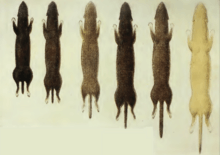
The least weasel has a high geographic variation, a fact which has historically led to numerous disagreements among biologists studying its systematics. Least weasel subspecies are divided into 3 categories:[8]
- The pygmaea–rixosa group (small weasels): Tiny weasels with short tails, pedomorphic skulls, and pelts that turn pure white in winter. They inhabit northern European Russia, Siberia, the Russian Far East, Finland, northern Scandinavian Peninsula, Mongolia, northeastern China, Japan and North America.[8]
- The boccamela group (large weasels): Very large weasels with large skulls, relatively long tails and lighter coloured pelts. Locally, they either do not turn white or only partially change colour in winter. They inhabit Transcaucasia, from western Kazakhstan to Semirechye and in the flat deserts of Middle Asia. They are also found in Morocco, Algeria, and Tunisia.[8]
- The nivalis group (average weasels): Medium-sized weasels, with tails of moderate length, representing a transitional form between the former two groups. They inhabit the middle and southern regions of European Russia, Crimea, Ciscaucasus, western Kazakhstan, southern and middle Urals and montane parts of Middle Asia, save for Koppet Dag.[8]
As of 2005,[9] 18 subspecies are recognised.
| Subspecies | Trinomial authority | Description | Range | Synonyms |
|---|---|---|---|---|
| Common weasel Mustela n. nivalis |
Linnaeus, 1766 | A medium-sized subspecies with a tail of moderate length, constituting about 20–21% of its body length. In its summer fur, the upper body is dark-brownish or chestnut colour, while its winter fur is pure white. It is probably a transitional form between the small pygmaea and large vulgaris[10] | Middle regions of European Russia, from the Baltic states to the middle and southern Urals, northward approximately to the latitude of Saint Petersburg and Perm, and south to the Kursk and Voronezh Oblasts. Outside the former Soviet Union, its range includes Northern Europe (excluding Ireland and Iceland) save for Finland and parts of the Scandinavian Peninsula | caraftensis (Kishida, 1936) kerulenica (Bannikov, 1952) |
| Allegheny weasel Mustela n. allegheniensis |
Rhoads, 1901 | Similar to Mustela n. rixosa, but is larger, has a broad skull and darker coat, and is more adapted to live in deciduous forests.[11] | Southeastern United States (Michigan, Pennsylvania, Virginia, North Carolina, Ohio, Illinois, Wisconsin, West Virginia, Indiana) | |
| Transcaucasian weasel Mustela n. boccamela
|
Bechstein, 1800 | A very large subspecies, with a long tail constituting about 30% of its body length. In its summer fur, the upper body is light brownish or chestnut with yellowish or reddish tints, with some individuals having a brownish dot on the corners of the mouth and sometimes on the chest and belly. The winter fur is not pure white, being usually dirty white with brown patches[12] | Transcaucasia, southern Europe, Asia Minor and probably western Iran | italicus (Barrett-Hamilton, 1900) |
| Plains weasel Mustela n. campestris |
Jackson, 1913 | Southwestern USA (South Dakota, Iowa, Nebraska, Kansas) | ||
| Mustela n. caucasica | Barrett-Hamilton, 1900 | dinniki (Satunin, 1907) | ||
| Mustela n. eskimo
|
Stone, 1900 | A small subspecies. Resembles Mustela n. rixosa, but has a duller colour, a larger skull and shorter tail.[13] | Alaska, Yukon, Northwest Territories | |
| Turkmenian weasel Mustela n. heptneri |
Morozova-Turova, 1953 | A very large subspecies with a long tail constituting about 25–30% of its body length. In its summer fur, the upper body is very light sandy brown or pale-yellowish. The fur is short, sparse and coarse, and does not turn white in winter[14] | Semideserts and deserts of southern Kazakhstan and Middle Asia from the Caspian Sea to Semirechye, southern Tajikistan, Koppet Dag, Afghanistan and northeastern Iran | |
| Korean weasel Mustela n. mosanensis |
Mori, 1927 | Korean Peninsula | ||
| Japanese weasel Mustela n. namiyei |
Kuroda, 1921 | Smaller than Mustela n. rixosa and paler than Mustela n. eskimo. Resembles Mustela n. pygmaea but the head and body are longer and the tail considerably longer.[15] | Japan | |
| Mediterranean weasel Mustela n. numidica
|
Pucheran, 1855 | Largest subspecies | Morocco, Algeria, Malta, Azores Islands and Corsica | albipes (Mina Palumbo, 1868) algiricus (Thomas, 1895) |
| Montane Turkestan weasel Mustela n. pallida |
Barrett-Hamilton, 1900 | A medium-sized subspecies with a tail constituting about 24% of its body length. The colour of the summer fur is light-brownish, while the winter fur is white[16] | Montane parts of Turkmenia, Uzbekistan, Tajikistan, Kazakhstan and Kirgizia, as well as Chinese parts of the same mountain systems and perhaps in the extreme eastern parts of Hindukush | |
| Siberian least weasel Mustela n. pygmaea |
J. A. Allen, 1903 | A very small subspecies, with a short tail which constitutes about 13% of its body length. In its summer coat, the dorsal colour is dark-brown or reddish, while the winter fur is entirely white[17] | All of Siberia, except southern nd southeastern Transbaikalia; northern and middle Urals, northern Kazakhstan and the Russian Far East including Sakhalin and Kuril Islands, European Russia westwards to the Kola Peninsula and southwards to the northern parts of the Kirovsky and Gorkovsk districts. Outside of the former USSR, its range includes Finland, northern Scandinavian and Korean Peninsulas, all of Mongolia save for the eastern part and probably northeastern China | kamtschatica (Dybowksi, 1922) |
| Bangs' weasel Mustela n. rixosa
|
Bangs, 1896 | The smallest subspecies. In its summer coat, the fur is dark reddish brown, while the winter fur is pure white[18] | Nunavut, Labrador, Quebec, Minnesota, North Dakota, Montana, Saskatchewan, Alberta, British Columbia | |
| Mustela n. rossica | Abramov and Baryshnikov, 2000 | |||
| Sichuan weasel Mustela n. russelliana |
Thomas, 1911 | Sichuan, southern China | ||
| Mustela n. stoliczkana | Blanford, 1877 | Kashgaria | ||
| Vietnamese weasel Mustela n. tonkinensis |
Björkegren, 1941 | Northern and southern Vietnam | ||
| Middle-European weasel Mustela n. vulgaris |
Erxleben, 1777 | A somewhat larger subspecies than nivalis, with a longer tail which constitutes about 27% of its body length. In its summer fur, the upper body varies from being light-brownish to dark-chestnut, while the winter fur is white in its northern range and piebald in its southern range[19] | Southern European Russia from the latitude of southern Voronezh and Kursk districts, Crimea, Ciscaucasia, northern slope of the main Caucasus, eastward to the Volga. Outside the former Soviet Union, its range includes Europe southward to the Alps and Pyrenees | dumbrowskii (Matschie, 1901) hungarica (Vásárhelyi, 1942) |
Description
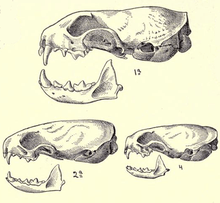
The least weasel has a thin, greatly elongated and extremely flexible body with a small, yet elongated, blunt-muzzled head which is no thicker than the neck. The eyes are large, bulging and dark coloured. The legs and tail are relatively short, the latter constituting less than half the body length. The feet are armed with sharp, dark-coloured claws, and the soles are heavily haired.[20] The skull, especially that of the small rixosa group, has an infantile appearance when compared with that of other members of the genus Mustela (in particular, the stoat and kolonok). This is expressed in the relatively large size of the cranium and shortened facial region.[21] The skull is, overall, similar to that of the stoat, but smaller, though the skulls of large male weasels tend to overlap in size with those of small female stoats.[22] There are usually four pairs of nipples but these are only visible in females. The baculum is short, 16 to 20 mm (0.6 to 0.8 in), with a thick, straight shaft. Fat is deposited along the spine, kidneys, gut mesentries and around the limbs. The least weasel has muscular anal glands under the tail, which measure 7 by 5 mm (0.3 by 0.2 in), and contain sulphurous volatiles, including thietanes and dithiacyclopentanes. The smell and chemical composition of these chemicals are distinct from those of the stoat.[22] The least weasel moves by jumping, the distance between the tracks of the fore and hind limbs being 18 to 35 cm (7 to 14 in).[23]

Dimensions vary geographically, to an extent rarely found among other mammals. Least weasels of the vulgaris group, for example, may outweigh the smaller races by almost four times. In some large subspecies, the male may be 1.5 times longer than the female. Variations in tail length are also variable, constituting from 13–30% of the length of the body. Average body length in males is 130 to 260 mm (5 to 10 in), while females average 114 to 204 mm (4.5 to 8.0 in). The tail measures 12 to 87 mm (0.5 to 3.4 in) in males and 17 to 60 mm (0.7 to 2.4 in) in females. Males weigh 36 to 250 g (1.3 to 8.8 oz), while females weigh 29 to 117 g (1.0 to 4.1 oz).[24]
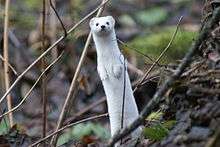
The winter fur is dense, but short and closely fitting. In northern subspecies, the fur is soft and silky, but coarse in southern forms. The summer fur is very short, sparser and rougher. The upper parts in the summer fur are dark, but vary geographically from dark-tawny or dark-chocolate to light pale tawny or sandy. The lower parts, including the lower jaw and inner sides of the legs, are white. There is often a brown spot at the corner of the mouth. The dividing line between the dark upper and light lower parts is usually straight but sometimes forms an irregular line. The tail is brown, and sometimes the tip is a little darker but it is never black. In the northern part of its range and at high altitudes, the least weasel changes colour in the winter, the coat becoming pure white and exhibiting a few black hairs in rare circumstances.[21][25]
Behaviour and ecology
Reproduction and development
The least weasel mates in April–July and there is a 34- to 37-day gestation period. In the Northern Hemisphere, the average litter size consists of 6 kits and these reach sexual maturity in 3 to 4 months. Males may mate during their first year of life, though this is usually unsuccessful. They are fecund in February–October, though the early stages of spermatogenesis do occur throughout the winter months. Anestrus in females lasts from September until February.[26]
The female raises its kits without help from the male. They are 1.5 to 4.5 g (0.05 to 0.16 oz) in weight at birth. Newborn kits are born pink, naked, blind and deaf, but gain a white coat of downy fur at the age of 4 days. At 10 days, the margin between the dark upper parts and light under parts becomes visible. The milk teeth erupt at 2 to 3 weeks of age, at which point the young start to eat solid food, though lactation can last 12 weeks. The eyes and ears open at 3 to 4 weeks of age, and by 8 weeks, killing behaviour is developed. The family breaks up after 9 to 12 weeks.[26] There is a single litter each year and least weasels can live for 7 or 8 years.[25]
Territorial and social behaviours
.jpg)
The least weasel has a typical mustelid territorial pattern, consisting of exclusive male ranges encompassing multiple female ranges. The population density of each territory depends greatly on food supply and reproductive success, thus the social structure and population density of any given territory is unstable and flexible.[27] Like the stoat, the male least weasel extends its range during spring or during food shortages. Its scent marking behaviour is similar to that of the stoat; it uses faeces, urine and anal and dermal gland secretions, the latter two of which are deposited by anal dragging and body rubbing. The least weasel does not dig its own den, but nests in the abandoned burrow of another species such as a mole or rat.[28] The burrow entrance measures about 2.5 cm (0.98 in) across and leads to the nest chamber located up to 15 cm (5.9 in) below ground. The nest chamber (which is used for sleeping, rearing kits and storing food) measures 10 cm (3.9 in) in diameter, and is lined with straw and the skins of the weasel's prey.[29]
The least weasel has four basic vocalisations; a guttural hiss emitted when alarmed, which is interspersed with short screaming barks and shrieks when provoked. When defensive, it emits a shrill wail or squeal. During encounters between males and females or between a mother and kits, the least weasel emits a high-pitched trilling. The least weasel's way of expressing aggression is similar to that of the stoat. Dominant weasels exhibit lunges and shrieks during aggressive encounters, while subdominant weasels will emit submissive squeals.[28]
Diet
The least weasel feeds predominantly on mouse-like rodents, including mice, hamsters, gerbils and others. It usually does not attack adult hamsters and rats. Frogs, fish, small birds and bird eggs are rarely eaten. It can deal with adult pikas and gerbils, but usually cannot overcome brown rats and sousliks. Exceptional cases are known of least weasels killing prey far larger than themselves, such as capercaillie, hazel hen and hares.[30] In England, a favoured prey item is the field vole (Microtus agrestis). These have fluctuations in population size, and in years of abundance may form up to 54% of the weasel's diet. In years of scarcity, birds form a greater proportion of the diet and female least weasels may fail to breed.[31]
Despite its small size, the least weasel is a fierce hunter, capable of killing a rabbit five to ten times its own weight.[32] Although they are commonly taken, the rabbits are usually young specimens, and become an important food source during the spring, when small rodents are scarce and rabbit kits are plentiful. Male least weasels take a higher proportion of rabbits than females, as well as an overall greater variety of prey. This is linked to the fact that being larger, and having vaster territorial ranges than females, males have more opportunities to hunt a greater diversity of prey.[33]
The least weasel forages undercover, to avoid being seen by foxes and birds of prey. It is adapted for pursuing its prey down tunnels, though it may also bolt prey from a burrow and kill it in the open.[33] The least weasel kills small prey, such as voles, with a bite to the occipital region of the skull[30] or the neck, dislocating the cervical vertebrae. Large prey typically dies of blood loss or circulatory shock.[33] When food is abundant, only a small portion of the prey is eaten, usually the brain. The average daily food intake is 35 g (1 oz), which is equivalent to 30–35% of the animal's body weight.[30]
Predators and competitors
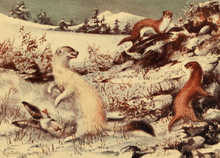
The least weasel is small enough to be preyed upon by a range of other predators.[34] Least weasel remains have been found in the excrement of red foxes, sables, steppe and forest polecat, stoats, eagle owls and buzzards.[35] The owls most efficient at capturing least weasels are barn, barred, and great horned owls. Other birds of prey threatening to the least weasel include broad-winged and rough-legged buzzards. Some snake species may prey on the least weasel, including the black rat snake and copperhead.[29] Aside from its smaller size, the least weasel is more vulnerable to predation than the stoat because it lacks a black predator deflection mark on the tail.[34]
In areas where the least weasel is sympatric with the stoat, the two species compete with each other for rodent prey. The weasel manages to avoid too much competition by living in more upland areas, feeding on smaller prey and being capable of entering smaller holes. It actively avoids encounters with stoats, though female weasels are less likely to stop foraging in the presence of stoats, perhaps because their smaller size allows them to quickly escape into holes.[36]
Diseases and parasites
Ectoparasites known to infest weasels include the louse Trichodectes mustelae and the mites Demodex and Psoregates mustela. The species may catch fleas from the nests and burrows of its prey. Flea species known to infest weasels include Ctenophthalmus bisoctodentatus and Palaeopsylla m. minor, which they get from moles, P. s. soricis, which they get from shrews, Nosopsyllus fasciatus, which they get from rodents and Dasypsyllus gallinulae which they get from birds.[34]
Helminths known to infest weasels include the trematode Alaria, the nematodes Capillaria, Filaroides and Trichinella and the cestode Taenia.[34] Least weasels are commonly infected with the nematode Skrjabingylus nasicola, adults of which are found in the nasal sinuses and can damage the skull. There is no evidence that this has serious detrimental effects on even heavily infested animals.[37]
Distribution and habitat
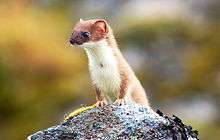
The least weasel has a circumboreal, Holarctic distribution, encompassing much of Europe and North Africa, Asia and parts of northern North America, where it occurs mainly in places where the stoat is not found, though it has been introduced in New Zealand, Malta, Crete, the Azore Islands and also Sao Tome off west Africa. It is found throughout Europe and on many islands, including the Azores, Britain (but not Ireland), and all major Mediterranean islands.[38] It also occurs on Honshu and Hokkaido islands in Japan and on Kunashir, Iturup, and Sakhalin Islands in Russia.[1]
The least weasel occupies a similar type of habitat as the stoat but it less often frequents wet places. It can be found in fields, open woodland, bushy or rocky areas, parks and gardens, and at altitudes of up to about 3,000 metres (9,800 ft).[25]
Conservation status
The least weasel has a very wide circumboreal range and a large total population and is therefore listed by the International Union for Conservation of Nature as being of "least concern". Its chosen habitat is in areas of coarse vegetation and in some regions its numbers may be decreasing because of changes in agricultural practices, but altogether its population trend is thought to be steady. It is relatively common in Eurasia but less abundant in North America and is thought to be rare in the southeastern United States. It is subject to considerable variations in numbers in areas where its main rodent prey is liable to large population fluctuations. In years of rodent population booms, the least weasel numbers may rise by up to ten-fold, only to slump again as prey becomes scarce again in the following years.[1]
In folklore and mythology

The Ancient Macedonians believed that to see a least weasel was a good omen. In some districts of Macedon, women who suffered from headaches after having washed their heads in water drawn overnight would assume that a weasel had previously used the water as a mirror, but they would refrain from mentioning the animal's name for fear that it would destroy their clothes. Similarly, a popular superstition in southern Greece had it that the least weasel had previously been a bride, who was transformed into a bitter animal which would destroy the wedding dresses of other brides out of jealousy.[39] According to Pliny the Elder, the least weasel is the only animal capable of killing the basilisk;
To this dreadful monster the effluvium of the weasel is fatal, a thing that has been tried with success, for kings have often desired to see its body when killed; so true is it that it has pleased Nature that there should be nothing without its antidote. The animal is thrown into the hole of the basilisk, which is easily known from the soil around it being infected. The weasel destroys the basilisk by its odour, but dies itself in this struggle of nature against its own self.[40]
The Chippewa believed that the least weasel could kill the dreaded wendigo giant by rushing up its anus.[41] In Inuit mythology, the least weasel is credited with both great wisdom and courage, and whenever a mythical Inuit hero wished to accomplish a valorous task, he would generally change himself into a least weasel.[42] According to Matthew Hopkins, a witch hunter general during the English Civil War, least weasels were the familiars of witches.[43]
References
- 1 2 3 Tikhonov, A.; Cavallini, P.; Maran, T.; Kranz, A.; Herrero, J.; Giannatos, G.; Stubbe, M.; Conroy, J.; Kryštufek, B.; Abramov, A.; et al. (2008). "Mustela nivalis". IUCN Red List of Threatened Species. Version 2008. International Union for Conservation of Nature. Retrieved 21 March 2009.
- ↑ Shorter Oxford English dictionary. United Kingdom: Oxford University Press. 2007. p. 3804. ISBN 0-19-920687-2.
- ↑ LONG JL 2003. Introduced Mammals of the World: Their History, Distribution and Influence (Cabi Publishing) by John L. Long (ISBN 9780851997483)
- ↑ Wilson, Don E.; Reeder, DeeAnn M., eds. (2005). Mammal Species of the World: A Taxonomic and Geographic Reference, Volume 12. JHU Press. pp. 616–617. ISBN 978-0-8018-8221-0.
- ↑ Heptner & Sludskii 2002, p. 972
- ↑ Kurtén 1968, pp. 102–103
- ↑ Macdonald 1992, p. 205
- 1 2 3 4 Heptner & Sludskii 2002, pp. 975–978
- ↑ Wozencraft, W.C. (2005). "Order Carnivora". In Wilson, D.E.; Reeder, D.M. Mammal Species of the World: A Taxonomic and Geographic Reference (3rd ed.). Johns Hopkins University Press. ISBN 978-0-8018-8221-0. OCLC 62265494.
- ↑ Heptner & Sludskii 2002, p. 982
- ↑ Rhoades, Samuel M. (1900). "A New Weasel from Western Pennsylvania". Proceedings of the Academy of Natural Sciences of Philadelphia. 52: 751–754. JSTOR 4062685.
- ↑ Heptner & Sludskii 2002, p. 980
- ↑ Swenk, Myron H. (1926). "Notes on Mustela campestris Jackson, and on the American Forms of Least Weasels". Journal of Mammalogy. 7 (4): 313–330. JSTOR 1373581. doi:10.2307/1373581.
- ↑ Heptner & Sludskii 2002, p. 981
- ↑ Kuroda, Nagamichi (1921). "On Three New Mammals from Japan". Journal of Mammalogy. 2 (4): 208–211. JSTOR 1373554. doi:10.2307/1373554.
- ↑ Heptner & Sludskii 2002, p. 984
- ↑ Heptner & Sludskii 2002, p. 978
- ↑ Merriam 1896, pp. 14–15
- ↑ Heptner & Sludskii 2002, p. 983
- ↑ Heptner & Sludskii 2002, pp. 967–969
- 1 2 Heptner & Sludskii 2002, p. 969
- 1 2 Harris & Yalden 2008, p. 468
- ↑ Heptner & Sludskii 2002, p. 991
- ↑ Heptner & Sludskii 2002, pp. 970–972
- 1 2 3 Konig, Claus (1973). Mammals. Collins & Co. p. 167. ISBN 978-0-00-212080-7.
- 1 2 Harris & Yalden 2008, p. 474
- ↑ Erlinge, S. (1974). "Distribution, Territoriality and Numbers of the Weasel Mustela nivalis in Relation to Prey Abundance". Oikus. 25 (3): 308–314. JSTOR 3543948.
- 1 2 Harris & Yalden 2008, pp. 471–472
- 1 2 Merritt & Matinko 1987, p. 277
- 1 2 3 Heptner & Sludskii 2002, pp. 987–988
- ↑ Tapper, Stephen (1979). "The Effect of Fluctuating Vole Numbers (Microtus agrestis) on a Population of Weasels (Mustela nivalis) on Farmland". Animal Ecology. 48 (2): 603–617. JSTOR 4182.
- ↑ Macdonald 1992, p. 208
- 1 2 3 Harris & Yalden 2008, pp. 472–473
- 1 2 3 4 Harris & Yalden 2008, p. 475
- ↑ Heptner & Sludskii 2002, p. 992
- ↑ Harris & Yalden 2008, p. 469
- ↑ King, Carolyn M. (1977). "The effects of the nematode parasite Skrjabingylus nasicola on British weasels (Mustela nivalis)". Journal of Zoology. 182 (2): 225–249. doi:10.1111/j.1469-7998.1977.tb04157.x.
- ↑ Rodrigues, M.; et al. (2016). "Origin and introduction history of the Least Weasels (Mustela nivalis) on Mediterranean and Atlantic islands inferred from genetic data". Biological Invasions.
- ↑ Abbott, G. A. (1903), Macedonian Folklore, pp. 108–109, Cambridge University Press
- ↑ Pliny the Elder (1855). John Bostock; Henry Thomas Riley, eds. "The Natural History". Retrieved 10 June 2009.
- ↑ Barnouw, Victor (1979) Wisconsin Chippewa Myths & Tales: And Their Relation to Chippewa Life, pp. 53, University of Wisconsin Press, ISBN 0-299-07314-9
- ↑ Dufresne, Frank (2005), Alaska's Animals and Fishes, pp. 109, Kessinger Publishing, ISBN 1-4179-8416-3
- ↑ Summers, Montague (2005) Geography of Witchcraft, pp. 29, Kessinger Publishing, ISBN 0-7661-4536-0
Bibliography
- Harris, Stephen; Yalden, Derek (2008). Mammals of the British Isles (4th Revised ed.). Mammal Society. ISBN 0-906282-65-9.
- Kurtén, Björn (1968). "Pleistocene mammals of Europe". Weidenfeld and Nicolson.
- Heptner, V. G.; Sludskii, A. A. (2002). Mammals of the Soviet Union. Vol. II, part 1b, Carnivores (Mustelidae and Procyonidae). Washington, D.C. : Smithsonian Institution Libraries and National Science Foundation. ISBN 90-04-08876-8.
- Macdonald, David (1992). "The Velvet Claw: A Natural History of the Carnivores". New York: Parkwest. ISBN 0-563-20844-9.
- Merriam, Clinton Hart (1896). Synopsis of the weasels of North America. Washington : Govt. Print. Off.
- Merritt, Joseph F.; Matinko, Ruth Anne (1987). Guide to the mammals of Pennsylvania. University of Pittsburgh Press. ISBN 0-8229-5393-5.
Further reading
- Coues, Elliott (1877). "Fur-bearing Animals: A Monograph of North American Mustelidae". Government Printing Office.
- Johnston, Harry Hamilton (1903). British mammals; an attempt to describe and illustrate the mammalian fauna of the British islands from the commencement of the Pleistocene period down to the present day. London, Hutchinson.
- Kurtén, Björn (1980). "Pleistocene mammals of North America". Columbia University Press. ISBN 0-231-03733-3.
External links
 Media related to Mustela nivalis at Wikimedia Commons
Media related to Mustela nivalis at Wikimedia Commons Data related to Mustela nivalis at Wikispecies
Data related to Mustela nivalis at Wikispecies- Smithsonian Institution – North American Mammals: Mustela nivalis


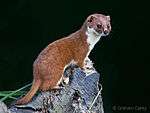
.jpg)
